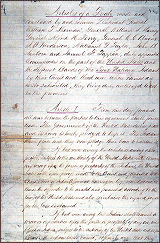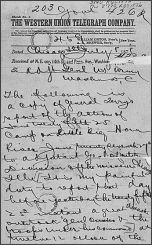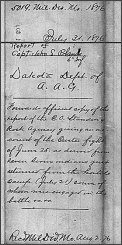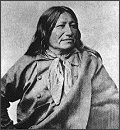
Sioux Treaty of 1868
Background
"This war was brought upon us by the children of the Great Father who came to take our land from us without price."
--Spotted Tail
The report and journal of proceedings of the commission appointed to obtain certain concessions from the Sioux Indians, December 26, 1876
The history of Native Americans in North America dates back thousands of years. Exploration and settlement of the western United States by Americans and Europeans wreaked havoc on the Indian peoples living there. In the 19th century the American drive for expansion clashed violently with the Native American resolve to preserve their lands, sovereignty, and ways of life. The struggle over land has defined relations between the U.S. government and Native Americans and is well documented in the holdings of the National Archives. (From the American Originals exhibit script.)
From the 1860s through the 1870s the American frontier was filled with Indian wars and skirmishes. In 1865 a congressional committee began a study of the Indian uprisings and wars in the West, resulting in a Report on the Condition of the Indian Tribes , which was released in 1867. This study and report by the congressional committee led to an act to establish an Indian Peace Commission to end the wars and prevent future Indian conflicts. The United States government set out to establish a series of Indian treaties that would force the Indians to give up their lands and move further west onto reservations.
In the spring of 1868 a conference was held at Fort Laramie, in present day Wyoming, that resulted in a treaty with the Sioux. This treaty was to bring peace between the whites and the Sioux who agreed to settle within the Black Hills reservation in the Dakota Territory.
The Black Hills of Dakota are sacred to the Sioux Indians. In the 1868 treaty, signed at Fort Laramie and other military posts in Sioux country, the United States recognized the Black Hills as part of the Great Sioux Reservation, set aside for exclusive use by the Sioux people. In 1874, however, General George A. Custer led an expedition into the Black Hills accompanied by miners who were seeking gold. Once gold was found in the Black Hills, miners were soon moving into the Sioux hunting grounds and demanding protection from the United States Army. Soon, the Army was ordered to move against wandering bands of Sioux hunting on the range in accordance with their treaty rights. In 1876, Custer, leading an army detachment, encountered the encampment of Sioux and Cheyenne at the Little Bighorn River. Custer's detachment was annihilated, but the United States would continue its battle against the Sioux in the Black Hills until the government confiscated the land in 1877. To this day, ownership of the Black Hills remains the subject of a legal dispute between the U.S. government and the Sioux.
For Further Reading
Agel, Jerome. Words That Make America Great. New York: Random House, 1997.
Colbert, David, ed. Eyewitness to America. New York: Pantheon Books, 1997.
Tindall, George Brown and Shi, David E. America: A Narrative History, New York: W.W. Norton and Company, 1992.
Ward, Geoffrey C. The West: An Illustrated History. Boston: Little Brown and Company, 1996.
The Documents
Sioux Treaty of 1868

Click to Enlarge
National Archives and Records Administration
General Records of the United States Government
Record Group 11
National Archives Identifier:
299803
General Alfred Terry's Telegram

Click to Enlarge
View Pages:
Endorsement
1 |
2
|
3 |
4
|
5 |
6
|
7 |
8
|
9
10 |
11
|
12 |
13
|
14 |
15
|
16
17 |
18
|
19 |
20
|
21
National Archives and Records Administration
Records of the Adjutant General's Office, 1780's-1917
Record Group 94
National Archives Identifier:
300379
Letter from Captain John S. Poland

Click to
Enlarge
View Pages: Endorsement | 1 | 2 | 3 | 4 | 5 | 6
National Archives and Records Administration
Records of United States Army Continental Commands, 1821-1920
Record Group 393
National Archives Identifier:
301973
Spotted Tail, a Brulé Sioux Chief of Great Renown

Click to Enlarge
National Archives
Still Picture Branch
111-SC-82538
National Archives Identifier:
285689
Selected Photographs of Custer's 1874 Expedition

Click to Enlarge
Camp at Hidden Wood Creek, 1874
National Archives and Records Administration
Department of the Army. Office of the Chief of Engineers
Record Group 77
National Archives Identifier:
519425
Column of Cavalry, Artillery, and Wagons, 1874
National Archives and Records Administration
Department of the Army. Office of the Chief of Engineers
Record Group 77
National Archives Identifier:
519427
Article Citation
This article was written by Linda Darus Clark, a teacher at Padua Franciscan High School, in Parma, OH.
